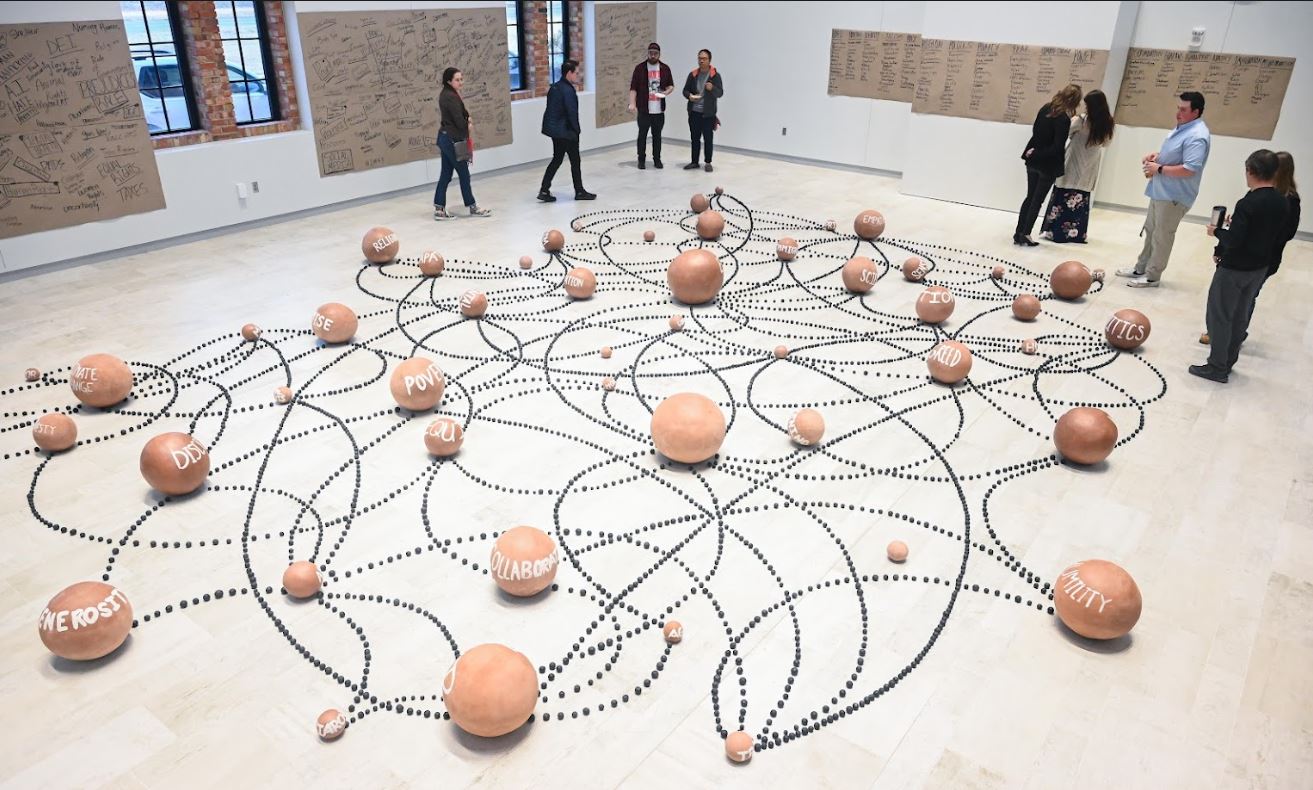By RORY MOORE
Tiger Media Network
Fort Hays State University’s Ceramica and Clay Club, Moss-Thorns Gallery, and School of Visual and Performing Arts featured Steve Hilton as a visiting artist to collaborate with students and faculty on a community installation project displayed at the Moss-Thorns Gallery of Art. Hilton, an established artist and professor at Midwestern State University in Wichita Falls, TX, came to work on the project from Oct. 28 to Nov. 1.
Hilton served as the facilitator for the project entitled “FHSU Issues and Solutions” and was one of 300 artists who put the installation together.
“I do installations all over the world but mostly in the United States,” he said. “I was asked to come, and I packed a bunch of clay, took a bunch of students, go to the site, and we make the artwork. It’s usually about the community, and in this case, it’s about the polarization of our society and how we can avoid that polarization.”
He aims to teach students how to resolve divisions through making art.
“My goal is to use art to start the conservation about what polarizes us and get students to think about what we can do as we build a community,” Hilton said. “I want to teach them to not use such vitriol when we talk to people that are different that us and think different than us. Teaching people about polarization through art is important, but the only way people are going to get this is if they think through it themselves. So, my goal is to give people the opportunity to be mindful.”
The installation consists of small black marbles connected with spheres that contain unifying ideas from students.
“Those spheres represent the words that polarize us and the possibilities of how we can be better,” Hilton said. “The black marbles connect the spheres in a way that I’m hopeful people can see that if we can educate people, we can make them less hateful.”
Hilton’s vision was conceptualized through students’ ideas about political matters who wrote their ideas on a paper displayed on the gallery’s walls.
Gallery Director and Interior Design Instructor Colin Schmidtberger was instrumental in the work’s process.
“I helped Steve understand how he would get here and what he all needed,” he said. “I helped install the paper on the walls as well as the marbles and the spheres on the floor. My job was to guide the conversation with Steve and help them set it up in a way that portrays what he’s trying to capture.”
Students materialized their ideas about unity by writing their thoughts on paper to tie into the installation.
“The words displayed on the wall influence how the floor is laid out and how they connect,” Schmidberger said. “The marbles connect different spheres that have the words on them, and those represent how everything is connected and how we as human beings can work together to have a better understanding of everyone and make a better world.”
Schmidtberger believes the project allows students to find comfort in expressing their views.
“I think this serves students in a sense of getting them to open up more,” he said. “This conversation was instigated to get them to understand that you have different views, but you can still be connected. You can still understand or accept someone’s different view. It doesn’t mean you have to be against them as a human being; you can still be friends and still have that relationship, and I think this helped them understand that.”
Freshman fine arts major Ashton Dawley contributed to the installation by discussing ideas with other students and writing words displayed on the spheres.
“On one wall, we have what bad things are in our world,” he said. “On the opposite wall, we have what could possibly solve those things. I’ve witnessed a lot of controversial topics, but I’ve also witnessed common ground topics in that it changes different perspectives of people’s thinking within an hour of class. So, I’m excited to see what this installation looks like because there’s so many words on all these walls.”
Dawley enjoyed working and discussing art with Hilton throughout the project.
“It’s fun talking to him,’ he said. “His mind challenges you and makes you think about what’s polarizing our world. When you talk to him in general, you start to think about challenging topics within the world, within art, and within yourself. It’s crazy what he can make your mind think in a short time.”
The installation will be displayed in the Moss-Thorns Gallery for the remainder of the month and is open to the public.
“I think it will turn out amazing,” Dawley said. “A lot of people don’t think about what polarizes our world because it’s a constant thing, and I think looking at something physical compared to what’s every day is going to stop us in our tracks and make us think more about it. That’s important because nobody likes to talk about it. Nobody is willing to make a change, and this installation is an attempt to make a change.”










